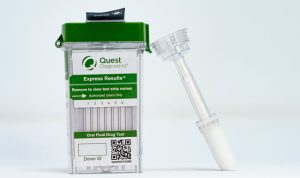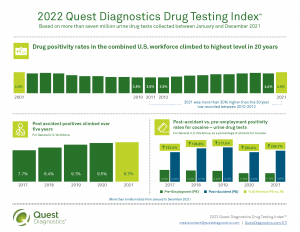Learn how integrating diagnostic testing into HR practices yields actionable insights, fostering informed decision-making and optimizing workforce management
In the contemporary workspace, the paradigm of employee health and wellness benefits is rapidly evolving. No longer confined to traditional health coverage, employers are prioritizing the inclusion of comprehensive, high-quality diagnostic testing within their wellness programs. This shift underscores an enlightened approach to preventive care, reflecting a broader organizational commitment to not only safeguarding employee health but also enhancing overall productivity and job satisfaction. By embracing diagnostic testing, employers are facilitating early detection and treatment of health issues, thereby promoting a healthier, more engaged workforce. This blog post aims to explore the current trends surrounding diagnostic testing in the workplace, delving into the tangible benefits for both employees and employers, and examining how these practices contribute to cultivating a thriving corporate culture.
Self-collections, virtual care, and health coaching—the next phase in self-care
Self-collection
Giving employees the option of completing a collection for a biometric screening at home is one way for employers to help bridge healthcare gaps within their population. For those who may not have easy access to a primary care doctor or a Quest patient service center, having the option to complete a collection for a health screening from the comfort of home may help them identify health risks they may have otherwise missed.
Virtual care
Ideally all employees will take their health screening results to their doctor to discuss their health risks and recommended actions for improving their health. However, the reality is that not all individuals have a primary care doctor, or they may have to wait a long time for an appointment. Through the Quest virtual care solution, an employee has the opportunity to virtually connect with a board-certified provider to discuss their screening results as soon as they are available. The provider can give them recommendations and next steps, and guide them into in-network care, if desired. Additionally, virtual care providers can provide quick, text-based assistance with other health concerns on an as-needed basis.
Health coaching
Many employers recognize the value of offering health screenings to their employees, but often the missing piece is the “what next.” Screening itself isn’t what makes employees healthier; instead, it is the action taken based on those results that leads to improved health. Health coaching can provide that “what next,” with personalized plans and support based on an individual’s health risks and needs. With health coaching, employees engage with a Health Advisor through calls, email, and text messages to set SMART goals and take steps toward achieving their desired outcomes.
The Growing Emphasis on Preventive Healthcare in the Workplace
Preventive vs Reactive Healthcare
The transition from reactive to preventive healthcare in the workplace marks a significant shift in employer-sponsored health benefits. In the past, the focus was predominantly on addressing health issues as they arose. Today, with the rising prevalence of chronic diseases and the associated spiraling healthcare costs, there’s a growing recognition of the value of early detection and prevention. This preventative approach, underscored by the accessibility of diagnostic testing, is seen as a critical strategy in enhancing employee well-being and managing healthcare expenditures more effectively.
Supporting Statistics
The economic and health benefits of preventive care are compelling. The Centers for Disease Control and Prevention (CDC) highlights that chronic diseases, many of which are preventable through early intervention, are responsible for 75% of national healthcare expenses. Furthermore, the World Health Organization (WHO) supports the efficacy of early disease detection, noting that it can dramatically reduce the global health burden. By focusing on preventive healthcare, employers can play a pivotal role in reversing these trends, offering a beacon of hope for a healthier future.
A 2018 Harvard Business Review study on the impact of individual health coaching on overall employee wellness found that the programs that supported health coaching programs showed better employee holistic wellness.
Trends in Workplace Diagnostic Testing
- On-site Diagnostic Services
- The introduction of on-site diagnostic services is a game changer for corporate health initiatives. By facilitating health screenings and tests within the workplace, employers are significantly lowering the barriers to healthcare access. This convenience encourages greater participation among employees while promoting a culture of wellness and proactive health management.
- Digital Health and Telemedicine
- The rise of digital health solutions, particularly telemedicine, has revolutionized access to diagnostic testing. Telemedicine platforms offer employees the flexibility to consult with healthcare professionals and undergo preliminary diagnostics remotely. This innovation is particularly beneficial in bridging the gap for remote workers or those in underserved areas, ensuring that geographical location is no longer a barrier to receiving high-quality healthcare advice and diagnostic services.
- Personalized Approach to Health
- Advancements in health technology now allow for the generation of personalized health reports based on diagnostic tests. These reports can provide employees with invaluable insights into their health status, risk factors, and potential lifestyle adjustments to mitigate these risks. This personalized approach to health management empowers employees to take charge of their well-being, with concrete data to guide their health decisions and interventions.
Benefits of Accessible Diagnostic Testing for Employers and Employees
- Enhanced Health Outcomes
- The cornerstone of integrating diagnostic testing into workplace wellness programs is the promise of enhanced health outcomes. Early detection of health issues can lead to more effective management and treatment, significantly improving the prognosis for many conditions. The preventive model not only benefits the individual employee but also has a ripple effect, leading to a healthier, more resilient workforce.
- Increased Productivity
- The link between employee health and productivity is well-documented. Healthy employees exhibit higher levels of concentration, creativity, and overall work performance. The Centers for Disease Control and Prevention (CDC) shared research showing that employees in good health are more likely to delivery better performance and engagement in the workplace. This underscores the value of including diagnostic testing in wellness initiatives, highlighting its role in reducing absenteeism and enhancing employee engagement.
- Cost Savings
- Investing in preventive healthcare through accessible diagnostic testing can yield cost savings. For employers, this translates into lower health insurance premiums, reduced costs associated with sick leave, and a healthier, more productive workforce.
- Attracting and Retaining Talent
- In today’s competitive job market, a comprehensive wellness program that includes diagnostic testing can be a significant draw for potential hires. Recent data quoted by the Society for Human Resource Management (SHRM) revealed that 87% of employees have access to mental and emotional well-being offerings, but only 23% take advantage of those benefits. Offering these services may not only enhance a company’s attractiveness to top talent but may also foster loyalty among existing staff, contributing to higher retention rates.
Implementing Diagnostic Testing in Your Workplace: Best Practices
Ensuring that diagnostic testing services are both accessible and user-friendly is paramount. Employers can achieve this by providing services directly on-site, offering home testing kits or establishing partnerships with local healthcare providers. Education plays a crucial role in encouraging participation, with clear communication about the benefits and procedures of diagnostic testing essential for dispelling any concerns or misconceptions. Privacy and confidentiality must be rigorously upheld, with secure systems in place to protect sensitive health information. Lastly, ongoing evaluation and adaptation of health initiatives, informed by employee feedback and health outcome data, are essential for refining and enhancing these programs.
Some Supporting Statistics
-CDC’s findings: “Chronic diseases that are avoidable through preventive care services account for 75% of the nation’s healthcare spending” (Centers for Disease Control and Prevention, 2021).
– WHO’s advocacy for early detection: “Early detection and treatment of diseases through diagnostic testing can significantly reduce the global disease burden, particularly for chronic diseases such as cancer and diabetes” (World Health Organization, 2022).
-Example of corporate Initiative: Google and Apple are among the companies that have incorporated on-site healthcare services, including diagnostic testing, demonstrating a commitment to employee health and convenience (Harvard Business Review, 2020).
-Telemedicine usage stats: “The use of telemedicine services has increased by 38% since 2019, indicating a growing preference for remote healthcare solutions among both patients and healthcare providers” (American Telemedicine Association, 2021).
– Benefits of personalized health data: “Employees who receive personalized health reports are 20% more likely to engage in preventive health behaviors, such as regular exercise and healthier eating habits” (Journal of Personalized Medicine, 2021).
– Effectiveness of early detection: “Studies show that early detection of diseases like cancer and heart disease can improve survival rates by up to 30%” (National Cancer Institute, 2021).
– Link Between health and productivity: “Comprehensive wellness programs have been shown to result in a 4% increase in productivity year over year” (National Business Group on Health, 2020).
– Impact on healthcare spending: “Preventive healthcare services, including diagnostic testing, could save the U.S. healthcare system up to $102 billion annually” (CDC, 2021).
– Importance of health Benefits: “87% of employees consider health and wellness offerings when choosing an employer, highlighting the role of comprehensive benefits in attracting and retaining top talent” (Society for Human Resource Management, 2020).
Conclusion
The integration of diagnostic testing into employee wellness programs represents a transformative shift in corporate health initiatives. By prioritizing accessible, high-quality diagnostic services, employers are not only investing in the health and well-being of their workforce but are also laying the groundwork for a more productive, engaged, and satisfied team. As we look toward the future, the continued evolution and expansion of these programs will undoubtedly play a pivotal role in shaping the landscape of workplace wellness, with profound implications for both individual health and organizational success.
As you evaluate your workforce’s needs, we welcome the opportunity to chat and discover solutions that will fit your needs. Check out our website or connect with us online.
 Your Privacy Choices
|
Privacy Notices
|
Terms
|
Language Assistance / Non-Discrimination Notice | Asistencia de Idiomas / Aviso de no Discriminación | 語言協助 / 不䈚視通知
Your Privacy Choices
|
Privacy Notices
|
Terms
|
Language Assistance / Non-Discrimination Notice | Asistencia de Idiomas / Aviso de no Discriminación | 語言協助 / 不䈚視通知



















Learn how integrating diagnostic testing into HR practices yields actionable insights, fostering informed decision-making and optimizing workforce management
In the contemporary workspace, the paradigm of employee health and wellness benefits is rapidly evolving. No longer confined to traditional health coverage, employers are prioritizing the inclusion of comprehensive, high-quality diagnostic testing within their wellness programs. This shift underscores an enlightened approach to preventive care, reflecting a broader organizational commitment to not only safeguarding employee health but also enhancing overall productivity and job satisfaction. By embracing diagnostic testing, employers are facilitating early detection and treatment of health issues, thereby promoting a healthier, more engaged workforce. This blog post aims to explore the current trends surrounding diagnostic testing in the workplace, delving into the tangible benefits for both employees and employers, and examining how these practices contribute to cultivating a thriving corporate culture.
Self-collections, virtual care, and health coaching—the next phase in self-care
Self-collection
Giving employees the option of completing a collection for a biometric screening at home is one way for employers to help bridge healthcare gaps within their population. For those who may not have easy access to a primary care doctor or a Quest patient service center, having the option to complete a collection for a health screening from the comfort of home may help them identify health risks they may have otherwise missed.
Virtual care
Ideally all employees will take their health screening results to their doctor to discuss their health risks and recommended actions for improving their health. However, the reality is that not all individuals have a primary care doctor, or they may have to wait a long time for an appointment. Through the Quest virtual care solution, an employee has the opportunity to virtually connect with a board-certified provider to discuss their screening results as soon as they are available. The provider can give them recommendations and next steps, and guide them into in-network care, if desired. Additionally, virtual care providers can provide quick, text-based assistance with other health concerns on an as-needed basis.
Health coaching
Many employers recognize the value of offering health screenings to their employees, but often the missing piece is the “what next.” Screening itself isn’t what makes employees healthier; instead, it is the action taken based on those results that leads to improved health. Health coaching can provide that “what next,” with personalized plans and support based on an individual’s health risks and needs. With health coaching, employees engage with a Health Advisor through calls, email, and text messages to set SMART goals and take steps toward achieving their desired outcomes.
The Growing Emphasis on Preventive Healthcare in the Workplace
Preventive vs Reactive Healthcare
The transition from reactive to preventive healthcare in the workplace marks a significant shift in employer-sponsored health benefits. In the past, the focus was predominantly on addressing health issues as they arose. Today, with the rising prevalence of chronic diseases and the associated spiraling healthcare costs, there’s a growing recognition of the value of early detection and prevention. This preventative approach, underscored by the accessibility of diagnostic testing, is seen as a critical strategy in enhancing employee well-being and managing healthcare expenditures more effectively.
Supporting Statistics
The economic and health benefits of preventive care are compelling. The Centers for Disease Control and Prevention (CDC) highlights that chronic diseases, many of which are preventable through early intervention, are responsible for 75% of national healthcare expenses. Furthermore, the World Health Organization (WHO) supports the efficacy of early disease detection, noting that it can dramatically reduce the global health burden. By focusing on preventive healthcare, employers can play a pivotal role in reversing these trends, offering a beacon of hope for a healthier future.
A 2018 Harvard Business Review study on the impact of individual health coaching on overall employee wellness found that the programs that supported health coaching programs showed better employee holistic wellness.
Trends in Workplace Diagnostic Testing
Benefits of Accessible Diagnostic Testing for Employers and Employees
Implementing Diagnostic Testing in Your Workplace: Best Practices
Ensuring that diagnostic testing services are both accessible and user-friendly is paramount. Employers can achieve this by providing services directly on-site, offering home testing kits or establishing partnerships with local healthcare providers. Education plays a crucial role in encouraging participation, with clear communication about the benefits and procedures of diagnostic testing essential for dispelling any concerns or misconceptions. Privacy and confidentiality must be rigorously upheld, with secure systems in place to protect sensitive health information. Lastly, ongoing evaluation and adaptation of health initiatives, informed by employee feedback and health outcome data, are essential for refining and enhancing these programs.
Some Supporting Statistics
-CDC’s findings: “Chronic diseases that are avoidable through preventive care services account for 75% of the nation’s healthcare spending” (Centers for Disease Control and Prevention, 2021).
– WHO’s advocacy for early detection: “Early detection and treatment of diseases through diagnostic testing can significantly reduce the global disease burden, particularly for chronic diseases such as cancer and diabetes” (World Health Organization, 2022).
-Example of corporate Initiative: Google and Apple are among the companies that have incorporated on-site healthcare services, including diagnostic testing, demonstrating a commitment to employee health and convenience (Harvard Business Review, 2020).
-Telemedicine usage stats: “The use of telemedicine services has increased by 38% since 2019, indicating a growing preference for remote healthcare solutions among both patients and healthcare providers” (American Telemedicine Association, 2021).
– Benefits of personalized health data: “Employees who receive personalized health reports are 20% more likely to engage in preventive health behaviors, such as regular exercise and healthier eating habits” (Journal of Personalized Medicine, 2021).
– Effectiveness of early detection: “Studies show that early detection of diseases like cancer and heart disease can improve survival rates by up to 30%” (National Cancer Institute, 2021).
– Link Between health and productivity: “Comprehensive wellness programs have been shown to result in a 4% increase in productivity year over year” (National Business Group on Health, 2020).
– Impact on healthcare spending: “Preventive healthcare services, including diagnostic testing, could save the U.S. healthcare system up to $102 billion annually” (CDC, 2021).
– Importance of health Benefits: “87% of employees consider health and wellness offerings when choosing an employer, highlighting the role of comprehensive benefits in attracting and retaining top talent” (Society for Human Resource Management, 2020).
Conclusion
The integration of diagnostic testing into employee wellness programs represents a transformative shift in corporate health initiatives. By prioritizing accessible, high-quality diagnostic services, employers are not only investing in the health and well-being of their workforce but are also laying the groundwork for a more productive, engaged, and satisfied team. As we look toward the future, the continued evolution and expansion of these programs will undoubtedly play a pivotal role in shaping the landscape of workplace wellness, with profound implications for both individual health and organizational success.
As you evaluate your workforce’s needs, we welcome the opportunity to chat and discover solutions that will fit your needs. Check out our website or connect with us online.